+7 (812) 929-8283
Cisco 2000, 4000 Wireless LAN Controller
Cisco 2000 Wireless LAN Controller
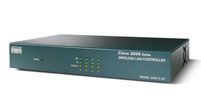 Контроллеры беспроводного доступа отвечают за такие функции беспроводной сети, как применение политик безопасности, предотвращение атак, управление радио эфиром, обеспечение качества обслуживания (QoS) и мобильность. Контроллеры работают совместно с "облегченными" точками доступа и системой управления Cisco Wireless Control System (WCS) для поддержки критически-важных приложений. Такие приложения включают в себя голосовые сервисы, передачу данных и отслеживание местоположение объектов. Контроллеры беспроводного доступа от Cisco предоставляют наибольшие возможности по управлению, масштабируемости и обеспечению безопасности для построения беспроводных сетей центральных офисов и филиалов.
Контроллеры беспроводного доступа отвечают за такие функции беспроводной сети, как применение политик безопасности, предотвращение атак, управление радио эфиром, обеспечение качества обслуживания (QoS) и мобильность. Контроллеры работают совместно с "облегченными" точками доступа и системой управления Cisco Wireless Control System (WCS) для поддержки критически-важных приложений. Такие приложения включают в себя голосовые сервисы, передачу данных и отслеживание местоположение объектов. Контроллеры беспроводного доступа от Cisco предоставляют наибольшие возможности по управлению, масштабируемости и обеспечению безопасности для построения беспроводных сетей центральных офисов и филиалов.
Беспроводные контроллеры то Cisco могут быть легко интегрированы в существующую корпоративную сети. Коммуникации между ними и точками доступа осуществляются на 2 уровне (Ethernet) или 3 уровне (IP) по протоколу Lightweight Access Point Protocol (LWAPP). Эти устройства также поддерживают автоматизацию большого количества функций по управлению беспроводной сетью.
Контроллеры Cisco 2000 серии поддерживают до 6 "облегченных" точек доступа и является идеальным решением для малых и средних предприятий или филиалов больших компаний.
Cisco 4400 Wireless LAN Controller
 Контроллеры беспроводного доступа отвечают за такие функции беспроводной сети, как применение политик безопасности, предотвращение атак, управление радио эфиром, обеспечение качества обслуживания (QoS) и мобильность. Контроллеры работают совместно с "облегченными" точками доступа и системой управления Cisco Wireless Control System (WCS) для поддержки критически-важных приложений. Такие приложения включают в себя голосовые сервисы, передачу данных и отслеживание местоположение объектов. Контроллеры беспроводного доступа от Cisco предоставляют наибольшие возможности по управлению, масштабируемости и обеспечению безопасности для построения беспроводных сетей центральных офисов и филиалов.
Контроллеры беспроводного доступа отвечают за такие функции беспроводной сети, как применение политик безопасности, предотвращение атак, управление радио эфиром, обеспечение качества обслуживания (QoS) и мобильность. Контроллеры работают совместно с "облегченными" точками доступа и системой управления Cisco Wireless Control System (WCS) для поддержки критически-важных приложений. Такие приложения включают в себя голосовые сервисы, передачу данных и отслеживание местоположение объектов. Контроллеры беспроводного доступа от Cisco предоставляют наибольшие возможности по управлению, масштабируемости и обеспечению безопасности для построения беспроводных сетей центральных офисов и филиалов.
Беспроводные контроллеры то Cisco могут быть легко интегрированы в существующую корпоративную сети. Коммуникации между ними и точками доступа осуществляются на 2 уровне (Ethernet) или 3 уровне (IP) по протоколу Lightweight Access Point Protocol (LWAPP). Эти устройства также поддерживают автоматизацию большого количества функций по управлению беспроводной сетью.
Контроллеры Cisco 4400 серии предназначен для средних и больших предприятий. Существуют две модели контроллера: 4402 с 2 портами Gigabit Ethernet и поддержкой 12, 25 и 50 "облегченных" точек доступа, а также модель 4404 с 4 портами Gigabit Ethernet и поддержкой 100 "облегченных" точек доступа.
Figure 1. Cisco 2000 Series and 4400 Series Wireless LAN Controllers
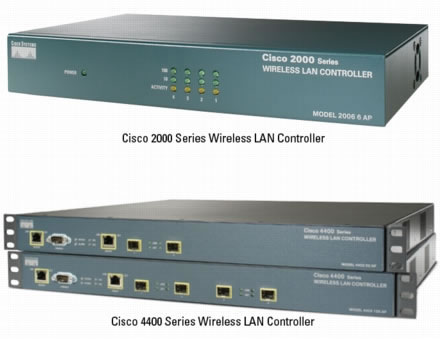
Figure 2. Integrated Controllers
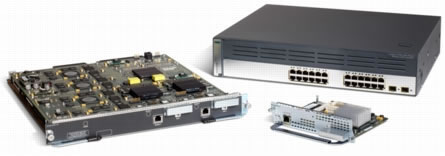
PRODUCT OVERVIEW
Cisco® Wireless LAN controllers are ideal for small, mid-sized, enterprise business and service provider wireless LAN deployments and provide system-wide wireless LAN functions, such as security policies, intrusion prevention, RF management, quality of service (QoS), and mobility. They work in conjunction with Cisco lightweight access points and Cisco Wireless Control System (WCS) Software to support business-critical wireless applications. From voice and guest access services to location tracking, WLAN controllers provide the control, scalability, and reliability that IT managers need to build secure, enterprise-scale wireless networks-from branch offices to outdoor campuses.
Cisco wireless LAN controllers smoothly integrate into existing enterprise and service provider networks. They communicate with Cisco lightweight access points over any Layer 2 (Ethernet) or Layer 3 (IP) infrastructure using the Lightweight Access Point Protocol (LWAPP) (Figure 3). This emerging IETF standard helps ensure that communication between access points and wireless LAN controllers remains secure, and it enables important wireless LAN configuration and management functions to be completely automated for cost-effective wireless LAN operations.
Figure 3. Centralized Wireless LAN
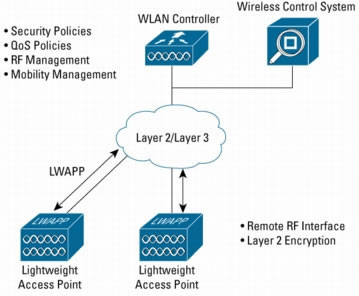
Cisco wireless LAN controllers enable enterprises to create and enforce policies for an end-to-end wireless LAN system that supports business critical applications. Multiple WLAN Controllers automatically discover each other and seamlessly coordinate WLAN services across themselves. In this way, Cisco wireless LAN controllers work together as a single, seamless system to deliver a scalable WLAN network with thousands of APs. From voice and data services to location tracking, Cisco wireless LAN controllers provide the control, scalability, and reliability that IT managers need to build secure, large-scale wireless networks.
Flexible Deployment Options
Cisco Systems offers several wireless LAN controllers that address different enterprise deployment scenarios. These include the Cisco 2000 Series, 4400 Series, Catalyst 6500 Wireless Services Module (WiSM), Wireless LAN Controller Module for Integrated Service Routers (ISR) and the Catalyst 3750G Integrated Wireless LAN Controller.
The Cisco 2000 Series delivers Cisco's award-winning wireless LAN services to small and medium-sized enterprise environments. It supports up to six lightweight access points, making it a cost-effective solution for smaller buildings. With integrated Dynamic Host Control Protocol (DHCP) services and zero-touch access point configuration, the Cisco 2000 Series is also ideal for environments with limited onsite IT support, such as branch offices within a distributed enterprise.
The Cisco 4400 Series Wireless LAN Controller is designed for medium to large size facilities and is available in two models-the 4402 with two Gigabit Ethernet ports comes in configurations that support 12, 25, and 50 access points, and the 4404 with four Gigabit Ethernet ports supports 100 access points. The 4402 provides one expansion slot and the 4404 provides two expansion slots that can be used to add VPN termination today, as well as enhanced functionality in the future. In addition, each 4400 WLAN Controller supports an optional redundant power supply to ensure maximum availability.
Wireless LAN controllers are also available for:
- Модуль в коммутатор Cisco Catalyst 6500 - Cisco Wireless Services Module (WiSM).
- Модуль в маршрутизаторы Cisco ISR - Сisco Wireless LAN Controller Module (WLCM).
- Cisco Catalyst 3750G Integrated Wireless LAN Controller.
Intelligent RF Management
All Cisco WLAN controllers come equipped with embedded software for adaptive real-time RF management. The Cisco WLAN system uses patent pending Radio Resource Management (RRM) algorithms that detect and adapt to changes in the air space in real-time. These adjustments create the optimal topology for wireless networking in much the same way that routing protocols compute the best possible topology for IP networks.
Figure 4. Network Wide RF Intelligence
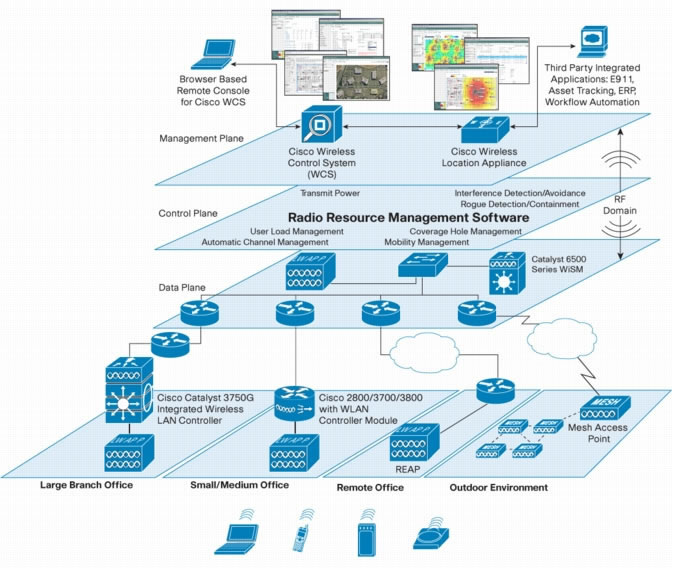
Specific intelligent RF capabilities managed by Cisco wireless LAN controllers include:
- Dynamic channel assignment-802.11 channels are adjusted to optimize network coverage and performance based on changing RF conditions.
- Interference detection and avoidance-The system detects interference and recalibrates the network to avoid performance problems.
- Load balancing-The system provides automatic load balancing of users across multiple access points for optimum network performance, even under heavy load.
- Coverage hole detection and correction-Radio Resource Management (RMM) software detects coverage holes and attempts to correct them by adjusting the power output of access points.
- Dynamic power control-The system dynamically adjusts the power output of individual access points to accommodate changing network conditions, helping to ensure predictable wireless performance and availability
Airtight Security
Cisco wireless LAN controllers adhere to the strictest level of security standards, including:
- 802.11i Wi-Fi Protected Access 2 (WPA2), WPA, and Wired Equivalent Privacy (WEP)
- 802.1X with multiple Extensible Authentication Protocol (EAP) types-Protected EAP (PEAP), EAP with Transport Layer Security (EAP-TLS), EAP with Tunneled TLS (EAP-TTLS), EAP-FAST, EAP-SIM and Cisco LEAP
- VPN termination-optional module for the 4400 Series that provides IP Security (IPSec) VPN termination
- Management Frame Protection
- Federal Information Processing Standards (FIPS) 140-2 Level 2 Validation
The result is the industry's most comprehensive wireless LAN security solution.
In the Cisco wireless LAN architecture, access points act as air monitors, communicating real-time information about the wireless domain to wireless LAN controllers. All security threats are rapidly identified and presented to network administrators via Cisco WCS, where accurate analysis can take place and corrective action can be taken.
Cisco provides the only wireless LAN system that offers simultaneous wireless protection and wireless LAN service delivery. This helps to ensure complete wireless LAN protection, with no unnecessary overlay equipment costs or extra monitoring devices. The Cisco wireless LAN system can be deployed initially as a standalone wireless intrusion prevention system, and reconfigured later to add Wireless LAN data service. This allows network managers to create a "defense shield" around their RF domains, containing unauthorized wireless activity until they are ready to deploy wireless LAN services.
Cisco addresses wireless LAN security by offering multiple layers of protection, including::
- RF security-Detect and avoid 802.11 interference and control unwanted RF propagation
- Wireless LAN intrusion prevention, location and correlation-The Cisco wireless LAN system not only detects rogue devices or potential wireless threats, but also locates these devices. This enables system administrators to quickly assess the threat level and take immediate action to mitigate threats as required. The IDS signature engine on controllers and on the Cisco WCS automatically eliminates duplicate alerts for rogue access points, rogue clients, and IDS signatures that previously occurred when two or more access points detected the same attacker. Now instead of one IDS alert from each detecting access point, a single alert is generated for the attack.
- Identity-based networking-IT staff must support many different user access rights, device formats, and application requirements when securing wireless LANs. The Cisco wireless LAN system enables enterprises to deliver individualized security policies to wireless users or groups of users. These include:
- Layer 2 security-802.1x (PEAP, TLS, TTLS, FAST, SIM, LEAP), WPA, 802.11i (WPA2)
- Layer 3 security (and above)-IPSec, web authentication
- VLAN assignments
- Access control lists (ACLs)-IP restrictions, protocol types, port, and differentiated services code point (DSCP) value
- QoS-multiple service levels, bandwidth contracts, traffic shaping and RF utilization
- Authentication, Authorization, and Accounting (AAA)/RADIUS-User session policies and rights management
- Management Frame Protection - Management frame protection (MFP) provides for the authentication of 802.11 management frames by the wireless network infrastructure. This allows the network to detect spoofed frames from access points or malicious users impersonating infrastructure access points.
- Network Admission Control (NAC)-Enforce policies pertaining to client configuration and behavior, to ensure that only end-user devices with appropriate security utilities can gain access to the network.
- Secure mobility-Maintain the highest level of security in mobile environments. This includes VPNs that follow users as they move, eliminating the need to re-establish secure tunnels. In addition, Cisco has developed Proactive Key Caching (PKC), an extension to the 802.11i standard and precursor to the 802.11r standard that facilitates secure roaming with AES encryption and RADIUS authentication.
- Guest tunneling-Provides additional security for access to the corporate network by guest users. It ensures that guest users are unable to access the corporate network without first passing through the corporate firewall.
- Secure backhaul-Encrypts data traffic over wireless backhaul links for additional security.
Figure 5. Multiple Layers of Wireless LAN Protection
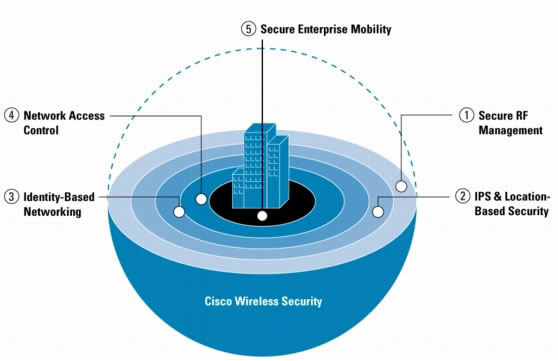
Real-Time Application Support
The Cisco wireless LAN system provides best-in-class performance to support real-time applications such as voice. Cisco wireless LAN controllers enable rapid handoff between access points and multiple controllers, providing smooth mobility with no interruption in service to the client. Intelligent queuing and contention management schemes provide effective resource management of the air space. In addition, Cisco wireless LAN controllers support PKC for real-time performance and mobility when using 802.11i security. Cisco also supports QoS capabilities that are Wi-Fi Multimedia (WMM)-compliant.
Mobility
Cisco wireless LAN controllers allow users to roam between and within indoor and outdoor environments, across access points, switches, and even across routed subnets. Security and QoS context information follows users wherever they roam, helping to ensure that mobility does not compromise performance, reliability, or privacy. Cisco wireless LAN controllers do not require any modifications to existing infrastructures or client devices to enable mobility (Mobile IP, for example). As a result, Cisco wireless LAN systems are easy to deploy, and cost-effective to own and operate.
Reliability
Cisco delivers the highest level of reliability for mission-critical wireless networks. In the event of an access point failure, wireless LAN controllers automatically adjust power on adjacent access points to cover the area where the failed access point provided service. In the event of an individual controller failure, access points automatically find a backup wireless LAN controller to keep wireless service available. Cisco wireless LAN controllers can be deployed in an N+1 redundant topology, allowing enterprises to scale their wireless networks while knowing that they are protected from both hardware and software disruptions. Only the Cisco wireless LAN solution allows users to control wireless deployment costs without sacrificing reliability. The Cisco 4400 Series supports redundant power supplies ensuring system operation even if a power supply fails.
FEATURES AND BENEFITS
Table 1. Features and Benefits of Cisco Wireless LAN Controllers
| Feature | Benefits |
|---|---|
| Scalability | Scalable architecture provides business-critical wireless services for locations of all sizes |
| Integrated Radio Resource Management (RRM) | Create an intelligent RF control plane for self-configuration, self-healing, and self-optimization |
| Zero-Configuration Deployment | The system is deployed without modifying existing routing and switching infrastructures, and without configuring access points |
| Multilayered Security | Flexible security policies adapt to changing corporate security needs |
| Intrusion Detection, Location, and Containment | Integrated wireless intrusion protection preserves the integrity of wireless networks and sensitive corporate information |
| Mobility Management | Intersubnet roaming without special client software facilitates device management; no changes to core routing infrastructure makes roaming easy |
| Reliability | Automated recovery from lightweight access point and Wireless LAN controller failures maximizes the availability of the wireless network |
| Intuitive Management Interfaces | Better visibility and control of the air space reduces operational cost |
PRODUCT SPECIFICATIONS
Table 2. Product Specifications for Cisco 2000 Series and 4400 Series Wireless LAN Controllers
| Item | Specification |
|---|---|
| Wireless | IEEE 802.11a, 802.11b, 802.11g, 802.11d, 802.11h |
| Wired/Switching/ Routing |
Cisco 2000 Series:
Cisco 4400 Series:
|
| Data RFCs |
|
| Security Standards | Cisco 2000 Series:
Cisco 4400 Series:
|
| Encryption | Cisco 2000 Series:
Cisco 4400 Series:
Wireless LAN Controller Module for Integrated Services Router (ISR):
Cisco Catalyst 3750G Integrated Wireless LAN Controller:
|
| AAA |
|
| Management |
|
| Management Interfaces |
|
| Interfaces and Indicators | Cisco 2000 Series:
Cisco 4400 Series:
|
| Physical and Environmental | Cisco 2000 Series:
Cisco 4400 Series:
Cisco Catalyst 6500 Series Wireless Services Module:
Cisco Catalyst 3750G Integrated Wireless LAN Controller Modules:
Cisco Wireless LAN Controller Module for Cisco Integrated Services Router (ISR)
|
ORDERING INFORMATION
Table 3. Ordering Information for Cisco 2000 Series,4400 Series Wireless LAN Controllers
| Part Number | Product Name |
|---|---|
| AIR-WLC2006-K9 | Cisco 2000 Series Wireless LAN Controller for up to six Cisco lightweight access points |
| AIR-WLC4402-12-K9 | 4400 Series WLAN Controller for up to 12 Cisco lightweight APs |
| AIR-WLC4402-25-K9 | 4400 Series WLAN Controller for up to 25 Cisco lightweight APs |
| AIR-WLC4402-50-K9 | 4400 Series WLAN Controller for up to 50 Cisco lightweight APs |
| AIR-WLC4404-100-K9 | 4400 Series WLAN Controller for up to 100 Cisco lightweight APs |
| AIR-PWR-4400-AC= | 4400 Series WLAN Controller AC Power Supply (redundant) |
| AIR-VPN-4400-K9= | 4400 Series WLAN Controller VPN Termination Module |

